Home | Category: Apostles and Saints Associated with Jesus
WAS MARY MAGDALENE A REAL PERSON
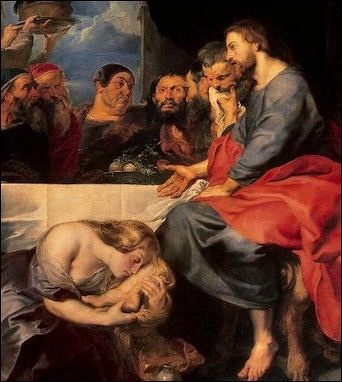
Mary Magdalene at the Feast of Simon the Pharisee by Rubens
According to the BBC: “We know very little about Mary herself. The Bible provides no personal details of her age, status or family. Her name, Mary Magdalene, gives us the first real clue about her. It suggests that she came from a town called Magdala. There is a place today called Magdala, 120 miles north of Jerusalem on the shores of the Sea of Galilee. We do know there was also an ancient place called Magdala from literature. The name occurs in the New Testament, and also in Jewish texts. Its full name is Magdala Tarichaea. Magdala seems to mean tower, and Tarichaea means salted fish. If the name of the town was Tower of Salted Fish, it's no surprise that its main business was fishing. As a woman living in Magdala, Mary may have worked in the fish markets. [Source: Susan Haskins and Belinda Sykes, July 20, 2011, BBC |::|]
“One Jewish text which mentions Magdala, called Lamentations Raba, says is that Magdala is judged by God and destroyed because of its fornication. It is possible that the description of Magdala as a place of fornication is the origin of the idea that arose in western Christianity that Mary Magdalene was a prostitute. We know there were brothels elsewhere in the Mediterranean, and Galilee was probably no exception. It was part of the Roman Empire, which placed a heavy tax burden on families, and often women paid the heaviest price. |::|
What else can be gleaned about Mary Magdalene is learned from the study of Jewish society and ancient Palestine 2,000 years ago, The Roman conquest, and then Roman imperial rule, would have made quite a dramatic impact on Galilee. Economically it would have brought the people greater and greater tax burdens, and that would have put pressure on families. When tax burdens were at their worst and a family could no longer pay off its debts, children were sometimes given up as slaves. Perhaps this was Mary Magdalene's fate. |::|
“With such a tough background, it's not hard to imagine that Mary might have been a prostitute, but this evidence is purely circumstantial. However, her name, Mary of Magdala, could suggest something else altogether: she was unmarried. A married woman would have carried her husband's name and Mary didn't. There is nothing in the limited amount of material we have about Mary in the Gospel traditions that suggests she is married, she's never described as being a widow and she not said to have any children. 2,000 years ago an unmarried woman was viewed with suspicion. Perhaps this isolated Mary, but it wouldn't fully account for her negative image. |::|
RECOMMENDED BOOKS:
“Mary Magdalene Revealed: The First Apostle, Her Feminist Gospel & the Christianity We Haven't Tried Yet” by Meggan Watterson and Hay House LLC Amazon.com ;
“The Gospel of Mary Magdalene” by Jean-Yves Leloup, Jacob Needleman, Amazon.com ;
“The Meaning of Mary Magdalene: Discovering the Woman at the Heart of Christianity”
by Cynthia Bourgeault Amazon.com ;
“Mary Magdalen: Myth and Metaphor” by Susan Haskins Amazon.com ;
“Mary Magdalene, the First Apostle: the Struggle for Authority” by Ann Graham Brock (2003) Amazon.com ;
“The Mary Magdalene Tradition: Witness and Counter-Witness in Early Christian Communities” by Holly E. Hearon (2003) Amazon.com ;
“The Resurrection of Mary Magdalene” by Jane Schaberg Amazon.com
Gospel of Mary
The Gospel of Mary is apocryphal text attributed to Mary Magdalene. It is a papyrus book found in a Cairo bazaar in 1896 by a German scholar who happened across it. Bound in leather and written in Coptic, it contains of Mary beginning some time after the resurrection and begins with the disciples having just had a vision of Jesus. According to the BBC:“Jesus has encouraged his disciples to go out and preach his teachings to the world, but they are afraid to do so because he was killed for it, and they say "if they killed him, they are going to kill us too". It's Mary who steps forward and says: don't be worried, he promised he would be with us to protect us. It says she turns their hearts toward the good and they begin to discuss the words of the Saviour. [Source: Susan Haskins and Belinda Sykes, July 20, 2011, BBC |::|]

Gospel of Mary
“In texts like the Gospel of Philip, Mary was presented as a symbol of wisdom. However in the Gospel of Mary, she is the one in charge, telling the disciples about Jesus' teachings. Mary, depicted as an old woman with her hair wrapped in a scarf, is looking down at a skull with her hands clasped, seeming deep in prayer Magdalena in Meditation by Jan Lievens © |::|
“At this point Peter asks Mary to tell them some things that she might have heard, but which the other disciples haven't. She says "Yes, I will tell you what has been hidden from you". She talks about a vision she had of Jesus and a conversation that she had with him. As the Gospel tells it, Mary then relates the details of this conversation, which is to do with spiritual development and the soul's lifelong battle with evil. |::|
“At this point controversy arises, and Andrew steps in and says "well, I don't know what the rest of you think, but these things seem very strange to me, and it seems that she's telling us teachings that are different from the Saviour." Peter then chimes in and he says, "Are we supposed to now all turn around and listen to her? Would Jesus have spoken privately with a woman rather than openly to us? Did he prefer her to us?" |::|
“Matthew defends Mary and quells Peter's attack on her. In the text, Peter's problem seems to be that Jesus selected Mary above the other disciples to interpret his teachings. Peter sees Mary as a rival for the leadership of the group itself. Peter need not have feared. Most people think of Peter as the rock upon which the church was established. He is the main or major disciple figure, and Mary Magdalene is a kind of side figure in the cast of characters. |::|
“One of the absolutely fascinating things about the Gospel of Mary is it really asks us to rethink that story about Christian history: did all the disciples get it? Did they really understand and preach the truth? Perhaps the Gospel of Mary was just too radical. It presents Mary as a teacher and spiritual guide to the other disciples. She's not just a disciple; she's the apostle to the apostles. |::|
Have Archaeologists Really Found Mary Magdalene’s Birthplace?
In January 2022, the Jerusalem Post reported that a “salvage excavation” (the kind of excavation performed ahead of construction in culturally rich areas) co-organized by the University of Haifa and the Israel Antiquities Association, unearthed the remains of a 2000-year-old synagogue in Migdal, Israel. Migdal is located on the Sea of Galilee and has traditionally been identified as Magdala, the hometown of Mary Magdalene. In a statement, excavation director Dina Avshalom-Gorni said “We can imagine Mary Magdalene and her family coming to the synagogue here, along with other residents of Migdal, to participate in religious and communal events.” [Source: Candida Moss, Daily Beast, January 2, 2022]
Candida Moss wrote in the Daily Beast: “The unearthing of the synagogue is, in fact, the second such discovery in the town. In 2009 a larger, more ornate synagogue was unearthed complete with an elaborately carved stone that featured a seven-branched menorah. Both synagogues date to the Second Temple period, when Jesus lived and preached in the area. The smaller synagogue consisted of a main hall and two other smaller rooms (one of which may well have housed Torah scrolls). The remnants of the accoutrements of ancient ritual life were present at the site. Pottery lamps, molded glass bowls, rings and some stone utensils were all round among the remains.
“Mere days after the news story broke, biblical scholars and Mary Magdalene experts Professor Joan Taylor, of King’s College London, and Duke University doctoral student Elizabeth Schrader published an important survey of the early evidence for “The Meaning of ‘Magdalene’” in the Journal of Biblical Literature. Three years in the making, this article reviews the literary data for much of what we know about Mary and comes to some persuasive and eye-opening conclusions about the meaning of her name.
Historical Evidence from Magdala, the Purported Hometown of Mary Magdalene
A synagogue dating to the time of Jesus and Mary Magdalene and thought to be modeled after the Jewish Temple in Jerusalem was unearthed in Magdala, the purported hometown of Mary Magdalene located on the Sea of Galilee. The Magdala Stone, which might have served as a ceremonial Torah stand found at the site is now kept in Israel’s national treasures storerooms. [Source: Kristin Romey, National Geographic, November 28, 2017 ^|^]
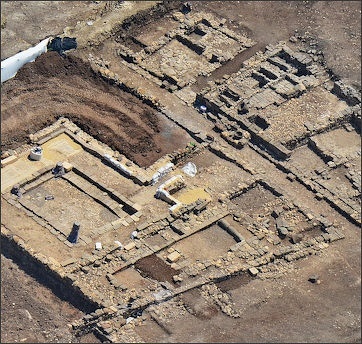
ancient synagogue in Magdala, Mary's hometown
In the 1970s, Franciscan archaeologists began excavating part of Magdala around a closed-down lakeside resort called Hawaii Beach. Kristin Romey wrote in National Geographic: “In 2009, archaeologists from the Israel Antiquities Authority showed up to survey the site, as required by law. After a few weeks of probing the rocky soil, they were startled to discover the buried ruins of a synagogue from the time of Jesus—the first such structure unearthed in Galilee. The find was especially significant because it put to rest an argument made by skeptics that no synagogues existed in Galilee until decades after Jesus’ death. If those skeptics were right, their claim would shred the Gospels’ portrait of Jesus as a faithful synagogue-goer who often proclaimed his message and performed miracles in these Jewish meeting places. ^
“As archaeologists excavated the ruins, they uncovered walls lined with benches—indicating that this was a synagogue—and a mosaic floor. At the centre of the room they were astounded to find a stone about the size of a footlocker that showed the most sacred elements of the Temple in Jerusalem carved in relief. The discovery of the Magdala Stone, as the artefact has come to be called, struck a death blow to the once fashionable notion that Galileans were impious hillbillies detached from Israel’s religious centre. “As archaeologists continued to dig, they discovered an entire town buried less than a foot below the surface. The ruins were so well preserved that some began calling Magdala the “Israeli Pompeii.”
See Separate Article: ARCHAEOLOGICAL EVIDENCE RELATED TO JESUS IN THE NAZARETH, SEA OF GALILEE AREA africame.factsanddetails.com
Did Mary Magdalene Even Live in Magdala
The associated of Mary Magdalene with Magdala rests on two assumptions. Candida Moss wrote in the Daily Beast: First, that Magdalene is a kind of surname that gestures to her geographical origins as ancient names often did. Second, that this city by the sea was called “Magdala” in the first century A.D. Once you drill into the historical foundations of the argument, Schrader and Taylor show, cracks start to emerge. [Source: Candida Moss, Daily Beast, January 2, 2022]
“There was, Schrader told me, considerable disagreement about the meaning of Mary’s name. The fifth-century translator St. Jerome thought that it was a nickname, meaning “tower.” Nicknames like this were common in antiquity, especially among Jesus followers. Just as Peter was the “rock,” and James was the “just” so too Mary was the “tower of faith.” Some ancient authors did think it referred to her birthplace, but no two ancient writers thought the same thing. The prolific third-century theologian Origen did identify Magdala as Mary’s hometown, but never specified where it was located. This is especially strange as Origen spent much of his life in Caesarea and travelled around the Sea of Galilee. How well known could the city have been if Origen didn’t know where it was? In fact, he spends more time emphasizing that her name meant “Magnification” and was a fitting title for a “prominent” witness of the resurrection. Taylor told me that “Since ‘Magdala’ means ‘the tower’ (as well as ‘magnified’) in Aramaic and there were numerous places which were called ‘the tower of something’, Origen… and others could choose different identifications.” Given all these differences of opinion, Schraeder said, we certainly shouldn’t be rushing to geographically based conclusions: “Since there was no consensus in antiquity on the meaning of her name, modern assumptions that she came from a place by the Sea of Galilee are highly suspect.”
“Archaeological evidence shows that the town on the Sea of Galilee known today as Magdala was certainly a first-century fishing village. And it was just the sort of place from which Jesus recruited followers. The geography and chronology, however, is a little off. Taylor told The Daily Beast: “In the time of Jesus, there was a village named Migdal Nuniyya (the ‘fish-tower’) located very close by, just one ‘mil’ (about 1 km.) beyond the northern boundary of Tiberias, a city which lay further south than the present town. The Christian pilgrim site of Magdala lies about 6 km from Roman Tiberias on the other side of Mount Arbel, and the archaeology increasingly indicates it was a separate, sizeable town.” There’s no evidence from Christian sources that the pilgrimage site was called “Magdala” until the sixth century, when the site started to become a destination for religious tourists.
For the complete article from which the material here is derived see “Have We Really Found Mary Magdalene's Birthplace?” by Candida Moss in the Daily Beast thedailybeast.com
Jesus-Era Perfume Vials found in Mary Magdalene’s Home Town
In 2008. Franciscan archeologists working in Israel announced that they had found found vials of perfume that that may have been similar to that used by Mary Magdalene to wash Jesus' feet Reuters reported: “A team of Franciscan archaeologists digging in the biblical town of Magdala in what is now Israel say they have unearthed vials of perfume similar to those that may have been used by the woman said to have washed Jesus' feet. [Source: Reuters, November 12, 2008 /:]
“The perfumed ointments were found intact at the bottom of a mud-filled swimming pool, alongside hair and make-up objects, the director of the dig conducted by the group Studium Biblicum Franciscanum told the Terrasanta.net religious website. "If chemical analyses confirm it, these could be perfumes and creams similar to those that Mary Magdalene or the sinner cited in the Gospel used to anoint Christ's feet," Father Stefano de Luca, the lead archaeologist, told the website. /:\
“Mary Magdalene is cited in the New Testament as a steadfast disciple of Christ from whom seven demons were cast out. She is often considered the sinner who anointed Jesus' feet. "The discovery of the ointments in Magdala at any rate is of great importance. Even if Mary Magdalene was not the woman who washed Christ's feet, we have in our hands 'cosmetic products' from Christ's time," De Luca said. /:\
“Magdala was the name of an ancient town near the shores of the Sea of Galilee in what is now northern Israel. A Palestinian Arab village stood near the site until the war at Israel's establishment in 1948, and an Israeli town called Migdal now occupies the area. "It's very likely that the woman who anointed Christ's feet used these ointments, or products that were similar in composition and quality," De Luca said. Studium Biblicum Franciscanum supports research in biblical studies but focuses on archaeological excavation of sites linked to the New Testament and early Christianity in the Middle East.” /:\
Mary Magdalene Cave in France
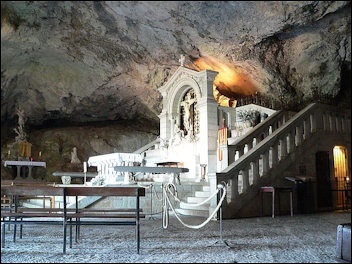
Mary Magdalene Cave in France
Andrew Todhunter wrote in National Geographic: “East of Aix-en-Provence, in the face of a broad, forested massif overlooking a high plain, lies the cave of Sainte-Baume. Here, according to Roman Catholic tradition, Mary Magdalene spent the last 30 years of her life. From the parking lot, a steep hike through the forest brings you to the cave and a small, adjoining monastery. On a clear June morning the cave's interior was noticeably colder than the air outside. In the candlelight a stone altar glowed in the center of the grotto, and statues of Mary Magdalene were visible in the cave's irregular corners. Two relics of the saint—a lock of hair and the presumed end of a tibia, dark with age, lay in a gilded reliquary. [Source: Andrew Todhunter, National Geographic, March 2012 |~|]
“ Although one tradition holds that she died in Ephesus, others maintain that she traveled from the Middle East to southern France. But establishing with scientific certainty that Mary Magdalene came to the hills of Provence, or that Thomas died in India, is likely to remain outside our grasp. Scientific analysis of relics is invariably inadequate, often confirming only that the bones are of the right gender and period. Advances in testing and archaeology, together with the discovery of yet unknown manuscripts, will continue to refine our historical knowledge of the saints. But much will remain inconclusive. How best, then, to understand these individuals if the reach of science is limited? As with most of the earliest Christians, we must rely largely on legend and historical accounts, acknowledging the power these mythic figures still exert today, some 2,000 years after their deaths. |~|
“I later spoke with Candida Moss, professor of New Testament and Christian origins at the University of Notre Dame. Moss has a particular interest in early martyrs; I asked if work had been done on the psychology of relics. "People have looked at relics as part of a grieving process," she said. "When my mother died, they offered each of us a piece of her hair to keep, and we all did. So I think anyone who has ever mourned would understand why you would fixate on things associated with someone you loved. Even more so in small Christian communities. The appeal was of a person in your midst, with whom you could have direct contact after his or her death." |~|
“In the cave of Sainte-Baume I sat in a rear pew during Mass, joined by a handful of pilgrims and a large group of cheerful French middle schoolers, arms crossed against the cold. Later, Fathers Thomas Michelet and François Le Hégaret led vespers. Sitting near me was Angela Rinaldi, a former pilgrim and a resident of the area since 2001. Rinaldi first came to the site with her companion at that time, a modern shaman drawn to Sainte-Baume not for its Catholic significance but for its reputation among shamans and New Age practitioners. Local tradition holds that the cave long ago served as a shrine for pagan fertility rites and endures as a pilgrimage site for those seeking feminine spirituality. The Catholic faith of Rinaldi's childhood eventually reasserted itself, and she began to help out at the small bookshop. |~|
“I asked how her perception of Mary had shifted while she'd been at Sainte-Baume. "In the beginning," she said, "I compared myself a lot to her … My life before was a constant seeking for something different, for something else. For a great love—not just love coming from another person but a love which can only come, I believe, from a spiritual dimension. There is some sort of force everywhere in this forest—not just in the cave. It has nothing to do with the representation of Mary Magdalene in the Gospel. It's an energy which makes you stand up afterward." She paused. "I don't know how to explain it," she said, laughing. "There is a silence in the cave which is full of life." |~|
“Such tenacity would have served her well if she did indeed spend three decades in the cold and damp of the Provence cave. "This is known as a place of penitence," Le Hégaret said. "In winter it's austere. Very few people come up to the cave. The road is frozen for weeks. There is a great simplicity here." He chuckled. "There is a proverb among the brothers of Provence: At Sainte-Baume either you go crazy, or you become a saint." With Christian Vacquié, the warden responsible for the ancient forest at Sainte-Baume, I visited a much smaller cave in the same massif that had contained the remains of Neanderthals from 150,000 years ago. This cave and others nearby have a distinctly female-reproductive organ shape, leading some to believe that they were fertility-cult sites in prehistoric times. One can imagine barren Neanderthals performing fertility rituals many tens of thousands of years before the arrival of Mary Magdalene.” |~|
Running the Mary Magdalene Cave in France
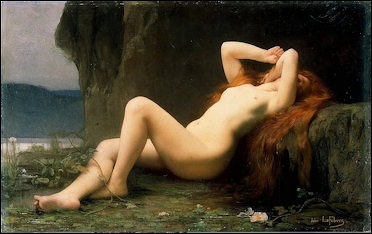
Mary Magdalene in The Cave
Andrew Todhunter wrote in National Geographic: “The cave has been cared for by the Dominican Order since 1295. Earlier in the day I visited with Michelet and Le Hégaret over lunch in the monastery's simple, beautifully antique dining room. Through its open leaded windows, from the monastery's great height upon the cliff face, the forest and the plain below could be seen for miles during breaks in the fog. [Source: Andrew Todhunter, National Geographic, March 2012 |~|]
“Protected by the state and cherished for its rich biological diversity, the forest itself has long been held sacred. "There was once a priest at the grotto," Vacquié told me with a grin, "who said that while he was Mary Magdalene's majordomo, I was her gardener." The forest and local caves are still believed to have a strong connection to fecundity, and women have come here for millennia to pray for children. To this day some women even rub their abdomens against the statues of Mary Magdalene as they pray. This physicality is not encouraged by the church, Le Hégaret told me, but it's difficult to prevent. On the walls of the cave are notes and plaques of gratitude in many languages. "Thank you Saint Mary Magdalene for healing my daughter," reads one in French dated October 1860. Another reads simply, "Merci pour Marion." |~|
“The Dominicans manage a hostel on the plain at the foot of the massif, the Hôtellerie de la Sainte-Baume, receiving pilgrims, students, scholars, and other travelers. There I spoke with Marie-Ollivier Guillou, a novitiate and former sailor who served four years as a priest on French submarines, including Le Terrible, before being transferred here two years ago. "For me," he said, "Mary Magdalene is the saint of love. She was a very courageous woman. She was one of the few who stayed at the Crucifixion. Most of the others ran for their lives, but Mary Magdalene stayed at the foot of the cross, ready to die for Christ. In this sense she is the model for the religious life." |~|
“Near the end of my time at Sainte-Baume I went back into the cave and climbed the short flight of steps to the rise of stone on which legend says Mary Magdalene slept; it's the only spot in the cave that remains dry. The last of the other visitors had left; fog rolled through the open doorway. Standing in the shadows, I reached through the grating and pressed my hand against the stone. The grotto was perfectly silent, save for the faintest occasional drip in the cistern, the same ancient spring that would have supplied the saint with fresh water. |~|
“When I had suggested to Thomas Michelet that Mary Magdalene may never have come to Provence, he replied in a matter-of-fact tone, "There was a priest who lived here at the cave for decades. He said that while it's impossible to know if Mary Magdalene truly came here in the first century, that certainty was of less importance. She's here now."” |~|
Mary Magdalene, the Da Vinci Code and the Catholic Church
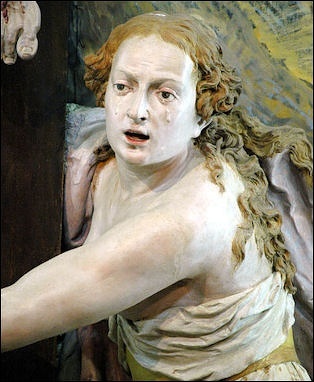
The Catholic church has long portrayed Mary Magdalene as a prostitute who redeemed herself . Pope Gregory I (540-604) is credited with raising the status of Mary Magdalene. He became pope in a time when of the plague was ravaging Europe and emphasized penitential forms of worship, and linked Mary Magdalene to that, as a way of warding off disease. In 1969 the Vatican acknowledged that she was not a fallen woman and formally apologized for giving her a bad rap.
Among those that believed Jesus and Magdalen were married were Martin Luther and Brigham Young. The notion that she was pregnant when Jesus was crucified was very popular in France, where several kings promoted the notion that the child founded the Merovngian line of European royals.
The book and film “The Da Vinci Code” popularized the belief that Mary Magdalene and Jesus were married and spurred an interest in all things related to Mary Magdalene and the various theories and conspiracies associated with her. The ones chosen by “Da Vinci Code” author Dan Brown included: 1) that Mary Magdalene is the Holy Grail; 2) that she not the disciple John is at Jesus’s right in the Da Vinci painting “The Last Supper” ; 3) the descendants of the child she had with Jesus founded France’s Merovingian dynasty; and 4) the aforementioned “truths” were deliberately suppressed by the Catholic Church. The book “Holy Blood, Holy Grail” by Michael Baigent, Richard Leigh and Henry Lincoln was the source of many of these ideas.
Image Sources: Wikimedia Commons except Mary Magdalene Cave in France from Catholic Travel Guide
Text Sources: Internet Ancient History Sourcebook: Christian Origins sourcebooks.fordham.edu “World Religions” edited by Geoffrey Parrinder (Facts on File); “ Encyclopedia of the World’s Religions” edited by R.C. Zaehner (Barnes & Noble Books, 1959); King James Version of the Bible, gutenberg.org; New International Version (NIV) of The Bible, biblegateway.com; Christian Classics Ethereal Library (CCEL) ccel.org , Frontline, PBS, Wikipedia, BBC, National Geographic, New York Times, Washington Post, Los Angeles Times, Smithsonian magazine, The New Yorker, Time, Live Science, Encyclopedia.com, Archaeology magazine, Reuters, Associated Press, Business Insider, AFP, Library of Congress, Lonely Planet Guides, Compton’s Encyclopedia and various books and other publications.
Last updated March 2024
